Why Bother with Sun Screen?

I sat in a thin gown waiting for the doctor to come in to see me. It was my first visit to the dermatologist and I was convinced I had skin cancer everywhere. My father had multiple spots removed and I was (am) quite pale, which meant I was at a higher risk for skin cancer. I also tried in vain to tan when I was a kid, trying to keep up with my beautifully tanned friends. Baby oil and blistering sunburns were my worst enemy. “How long has that spot been there?” the doctor asked. “Umm….. what spot??”
A punch biopsy and a week later I was back in her office having a Mohs procedure to remove a basal cell cancer above my lip. A couple years later, I had a pre-squamous cell spot removed with a topical chemotherapy cream. I used this as an education platform and many of my friends started filing into her office, some even had melanoma cancer removed. That began my love and devotion for sunscreen and here’s why you need to feel the same way.
Let’s learn a little bit about UV rays.
- UVA rays are the cancer causing and aging rays. They are the primary ray that causes tanning (which is the result of injuring the skin’s DNA and leads to damage, mutation and skin cancer).
- UVA rays are prevalent during all daylight hours, even in the winter, and can penetrate clouds and windows (do you drive or sit near a window during the day?).
- UVB rays are the burning and pre-cancer rays.
- The intensity of UVB rays vary with the season and time of day. They are at their peak from 10am to 4pm and spring to fall. But when the sun is out, you are still absorbing these rays.
A few facts, compliments of the Skin Cancer Foundation:
- Over the past three decades, more people have had skin cancer than all other cancers combined.
- About 90 percent of non-melanoma skin cancers are associated with exposure to ultraviolet (UV) radiation from the sun.
- One person dies of melanoma every hour (every 54 minutes).
- Ultraviolet (UV) radiation is a proven human carcinogen (this is from the sun or tanning beds).
- Twelve states plus the District of Columbia prohibit people younger than 18 from using indoor tanning devices: California, Delaware, Hawaii, Illinois, Louisiana, Massachusetts, Minnesota, Nevada, New Hampshire, North Carolina, Texas and Vermont. Oregon and Washington prohibit those under 18 from using indoor tanning devices, unless a prescription is provided.
- Individuals who have used tanning beds 10 or more times in their lives have a 34 percent increased risk of developing melanoma compared to those who have never used tanning beds.
- An estimated 90 percent of skin aging is caused by the sun.
- Your risk of developing melanoma doubles if you have had more than five sunburns.
So what can you do with this information?
- Start wearing sunscreen, daily. The best protection is broad spectrum UVA/UVB with SPF between 30-50.
- Wear protective clothing, hat and sunglasses when possible.
- Seek shade during the strongest UVB hours from 10am to 4pm.
- Use extra caution around sand, water, snow and pavement. They reflect damaging rays.
- Stop tanning. Either with natural sunlight or tanning beds.
- See a board certified dermatologist once per year for a professional skin examination
Still don’t want to wear a daily sunscreen? These are the excuses I hear at my office (from patients AND co-workers)
- The chemicals will increase my cancer risk!
False: The FDA has 17 approved active ingredients for sunscreens. If you’re still concerned consider using an all mineral (physical) sunscreen with the ingredients Zinc Oxide and Titanium Dioxide (both need to be 5 percent or higher to be effective)
- Sunscreen makes me break out!
True: Waterproofing chemical ingredients seal in oil and sweat. They can also be irritating for certain skin types. Use mineral sunscreens or non-waterproof sunscreens.
- I need to get my Vitamin D!
False: The safest way to get this vitamin is through a supplement or Vitamin D rich or fortified foods. Being outside for around 10 minutes will produce about 10,000 IU of Vitamin D.
- Sunscreens are so thick they won’t rub in and I look like a ghost!
True: Try a spray sunscreen (apply to your hands and then rub in) or look for a tinted sunscreen to take away the white mask. Powder sunscreens, like Colorescience, are also a great option.
- I hate the smell!
True: I hate the smell too. Testing out different formulas will help you find the right sunscreen for you. They all don’t smell.
Because I practice what I preach, I see my dermatologist every year and wear sunscreen daily. I always look for shaded options when I’m outside and wear a hat and big sunglasses and a sun shirt while on the beach or the lake. When I can’t avoid direct sun, I reapply my sunscreen at least every hour because of my tendency to burn thanks to getting pink in about 15 minutes of sun exposure. When patients ask what’s the number one product that will transform their skin I see disappointment in their faces when I tell them it’s sunscreen. So much damage can be prevented by using it daily!
So, to get ready for Spring Break and sunny weather, I’m offering 15% off all sunscreensin our office in March. I am here to find the best one for your skin!
Call our office at (615) 771-7718 for a consultation.
Written by Heather Happy, Licensed Esthetician
For more information on sun exposure and skin cancer please visit www.skincancer.org
